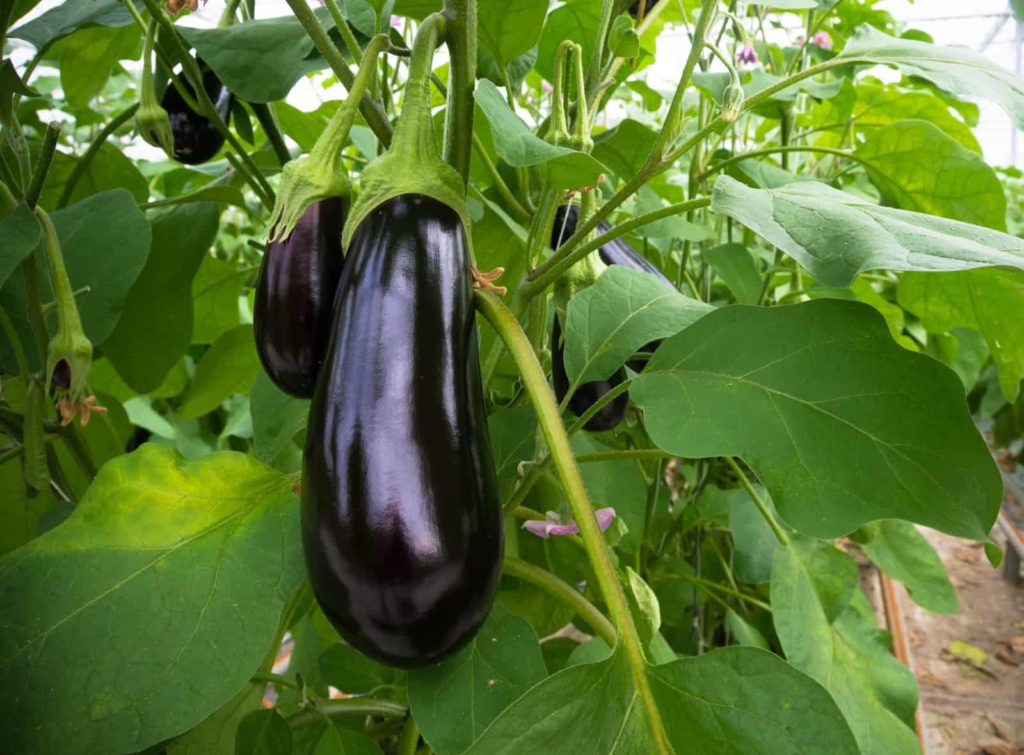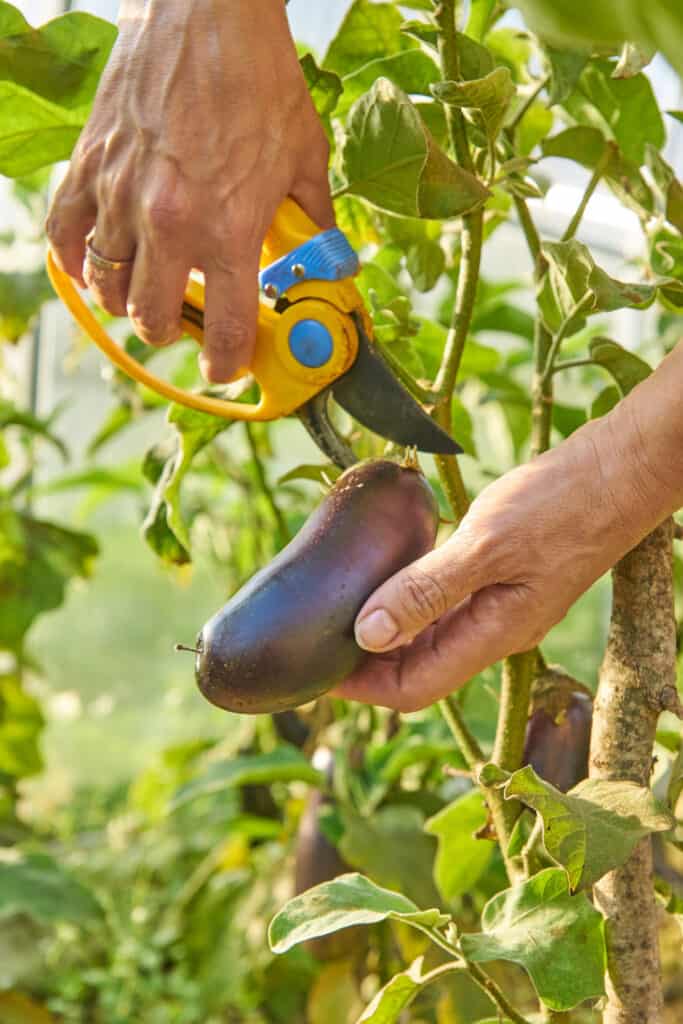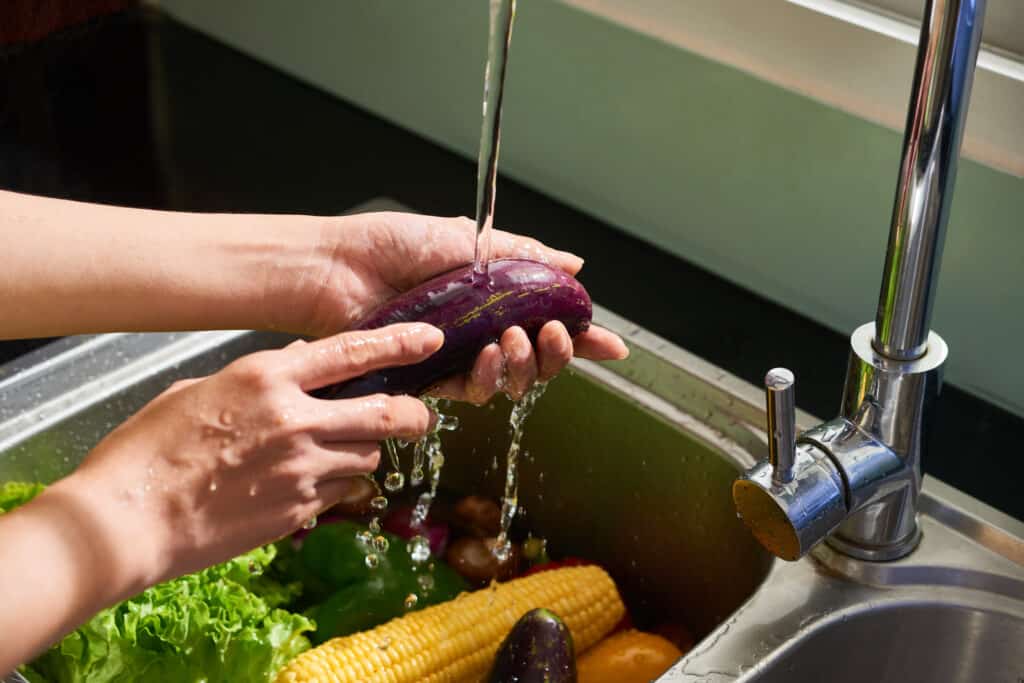Harvest eggplant young as soon as the skin becomes glossy. The flesh of young eggplant will be more tender and the seeds smaller. The plant will produce more fruit if kept picked.
Related articles:

When to harvest eggplant
- Harvest eggplants when they are firm and glossy and big enough to eat—about one-third of their maximum size.
- To test eggplant fruit for maturity, press the fruit with your thumb; if the flesh springs back it’s green and not ripe; if your thumb leaves an indentation, the fruit is overripe; the best-tasting eggplant will be in between.
- A just ripe eggplant when sliced will have soft, well-formed but immature seeds; an immature and unripe eggplant will have no visible seeds; an overripe eggplant will have hard, dark seeds. (Seeds forming inside the fruit cause the skin to go from shiny to dull.) Both an under-ripe and overripe eggplant will be bitter tasting.
It is better to harvest eggplant just before it’s ripe than to wait too long.
Kitchen Helpers from Amazon:
- Oster Vegetable Steamer
- Chef’s Knives Set of 6
- EZ Off Jar Opener for Weak Hands
- Pepper Core Remover Stainless Steel
- Kitchen Utensils – Set of 35
- Rachel Ray Non-Stick Cookware 12pcs

How to harvest eggplant
- Cut eggplant fruits from the plant with a garden pruner or sharp knife. Leave one inch of green stem attached to the fruit.
- Eggplants are very difficult to pull away from the plant by hand; doing so can damage the plant.

How to store eggplant
- Store eggplants in a room with high humidity to preserve texture and flavor and avoid dehydration. The optimal temperature for storing eggplant is 55°F (13°C). At 55°F, eggplants will keep for 1 to 2 weeks.
- You can store eggplant in the refrigerator but not cooler than 50°F (10°C). Rinse the fruit clean, pat it dry with a kitchen towel, and place it in a perforated plastic bag to keep it from drying out. (Refrigerators are cold and dry, not humid.)
- If exposed to temperatures below 41°F (5°C), eggplants will develop surface pits, bronzing, brown spots, and decay.
- Eggplant fruit discolors rapidly when cut open, so it’s best to use it immediately once sliced.
- Avoid storing eggplants with apples or tomatoes; ethylene (a natural plant hormone released in the form of a gas) given off by those fruits will cause eggplants to brown and decay.
Eggplant articles at Harvest to Table:
How to Plant and Grow Eggplant
How to Harvest and Store Eggplant
Eight Ways to Cook and Serve Eggplant
Eggplant Growing Problems: Troubleshooting
Garden Planning Books at Amazon:
- Vegetable Garden Almanac & Planner
- Kitchen Garden Grower’s Guide Vegetable Encyclopedia
- Vegetable Garden Grower’s Guide
- Tomato Grower’s Answer Book
More harvest tips:
Learn when and how to harvest your favorite vegetables for the best flavor and texture. Get storage tips for each crop. Click on the vegetable you are growing below.
- Artichoke
- Arugula
- Asparagus
- Beans
- Beets
- Broccoli
- Brussels Sprouts
- Cabbage
- Cantaloupe — Melons
- Carrots
- Cauliflower
- Celery
- Chard
- Collards
- Corn, Sweet
- Cucumbers
- Eggplant
- Endive and Escarole
- Garlic
- Jerusalem Artichoke
- Kale
- Kohlrabi
- Leeks
- Lettuce
- Melons
- Okra
- Onions
- Parsnips
- Peas
- Peppers
- Potatoes
- Pumpkins
- Radicchio
- Rhubarb
- Rutabaga
- Spinach
- Squash, Summer
- Squash, Winter
- Sunchokes
- Sweet Potato
- Swiss Chard
- Tomatillo
- Tomatoes
- Turnips
- Watermelon















